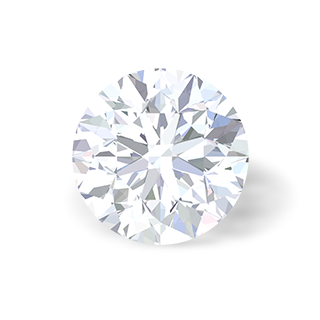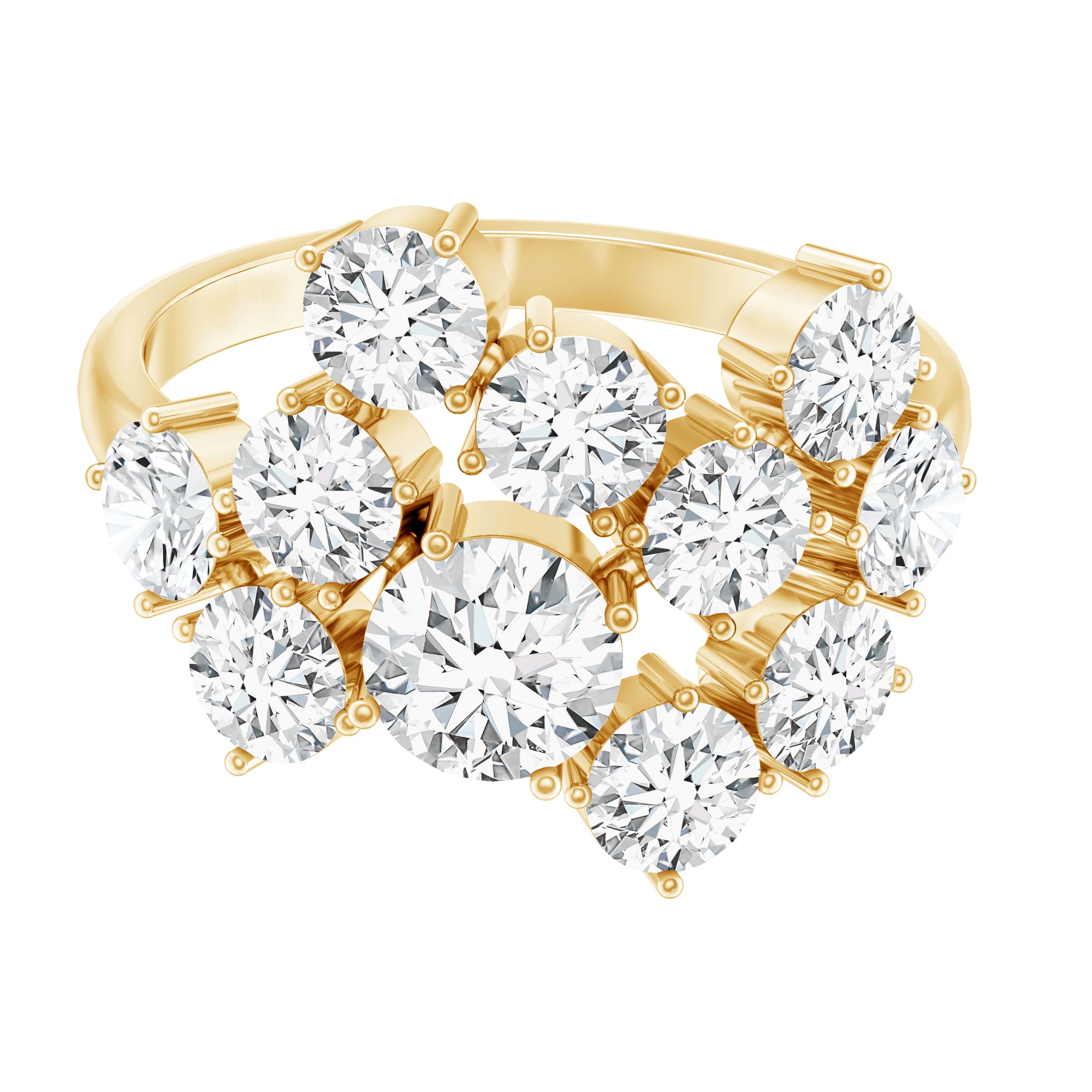All About Moissanite: Types, Colors, Description, Origins & Details
Sparkling, radiant and graceful! The colorless beauty of Moissanite is sure something that takes all of our hearts away. That’s probably why the craze for Moissanite is on the rise. Colorless gemstones have become a classic pick. Why not? The versatility is such that from proposing your ladylove with it to wearing it elegantly with your everyday outfits, its charm has got it all covered! We’re sure its sparkling brilliance has drawn you here as well. And that’s why we have come up with our very own moissanite education guide to address all the basic knowledge revolving around moissanites right from the most engrossing history and beliefs to the famous 4 C’s and properties for you to buy your moissanite jewelry right. Yes, everything that you’ve been looking for under one umbrella! Let’s begin!
Properties of Moissanite
Hardness
Having an impressive rating of 9.25 out of 10 on Moh’s scale, it is only surpassed by diamond when it comes to durability. It can withstand wear and tear of regular use. Got an idea why is it so sought after when it comes to daily wear jewelry?
Luster
Talking about fashion appeal and not having mentioned luster, well that’s quite impossible! Having a luster ranging from adamantine to metallic, it is sure famous for its polished, sparkling appearance.
Brilliance
This colorless beauty is known for its high refractive index of 2.65-2.69 which would give you an idea of its brilliance.
Origin & History
From where did this radiant gemstone come into picture? What is the story behind it? Don’t you want to know it all with our moissanite guide? Well, its history dates back to 1893 in Arizona when Henri Moissan, Nobel prize winning chemist, first discovered it while examining the rock that it arises in, typically in pieces of meteorites, but interestingly, he confused it with diamond (like, who wouldn’t?) and that too until 1904, when with great study, it was established that it was actually silicon carbide. You guessed it right, Moissanite got named as a tribute to the zeal of this chemist. But up until the mid 1900s, this semi precious stone was known to be pretty scarce.
Where is Moissanite found?
Where do you find this radiant beauty? Where exactly is it mined today? Although first discovered in Arizona, it was again found interestingly in diamond mines itself in Yakutia, Russia and Wyoming. Though initially discovered in Meteorites alone, it soon began to be formed in Xenoliths, Kimberite and lamproite, typically the igneous rocks famous for being diamond mines. Isn’t the formation of this colorless beauty itself what sets it apart from the rest? But due to its extreme scarcity, with intense research and hard-work, lab grown Moissanite is also available today which is formed from an artificial silicon carbide crystals. Pretty unique moissanite education, wasn’t it?
Moissanite versus Diamond

Moissanite
Moissanite, on the other side, is also colorless but not without greenish and yellowish tints. Only a high quality Moissanite is known to be completely colorless. Having a refractive index of about 2.65-2.69, Moissanite is known to be more brilliant than diamond, refracting a rainbow-like light. It is slightly cheaper than diamond as well.

Diamond
A completely colorless diamond is high quality but more easy to find. Apart from that, diamond has a refractive index of 2.417-2.419 and these refract a radiant white light. It is slightly on the pricier side as well.
Moissanite Quality and Price Filters
Here we arrive at the most important part! Wondering how to buy Moissanite jewelry? Our moissanite guide is here to help you get well versed with the 4 prominent factors that determine the quality of a stone, typically the famous 4 Cs, including color, clarity, carat and cut. Let’s take a glance:
Color
Color of Moissanite is graded using the similar grading system that is used for Diamond. The rule of the thumb must be - Lesser the Color in a Moissanite, the Higher is its Value.
Clarity
Another factor of measurement of grade while buying a moissanite is Clarity. Clarity can be defined as the measure of minor imperfections on and inside the moissanite.The flaws occurring on the surface are termed as Blemishes while the imperfections found trapped inside it are called Inclusions which are actually quite common in Moissanite. Graded from flawless inside out, internally flawless, very very slightly included, very slightly included to very slightly included, slightly included and included with eye visible blemishes, Moissanite comes in a whole range of stones possessing different clarity grades.
Carat
Compared to diamonds, moissanites have lower density and therefore weigh approximately 10% less. It is known to range between 0.01 to over 2 CT in our collection.
Cut
The fourth factor of measurement is the Cut of a Moissanite and perhaps the most important one as the Cut determines how well a moissanite can return the light back to your eye. It is the Cut of the Moissanite which makes it sparkle! While an emerald cut is known to best reflect the clarity of moissanite, a round, oval or pear cut on the other hand tells you a lot of its refractive ability and thus brilliance.
Moissanite Grading Value
How to judge the overall quality of your Moissanite better? Simple! Have a look at its grading system. Easy and efficient, isn’t it? A grading system for long has been one of the best methods to judge the quality of anything and everything! Let’s give you a glance at our moissanite grading chart. The color of Moissanite is the dominant determinant of its quality and it is typically graded as follows:
D-F
The Moissanite belonging to this color grade is known to be extremely valuable, since it is purely colorless, inhabiting a sparkle like no other.
G-I
Another sought after color grade of Moissanite with a near colorless appearance. You can witness slight yellowish tints but no worries! These are also quite valuable.
J-K
Just like diamond, Moissanite comes in a number of fancy shades including pink, grey, green, blue and yellow.
Benefits of Moissanite
Of course, every stone comes with its share of spiritual and astrological beliefs and Moissanite is no less. Just like its radiant shine that can illuminate the entire room, it provides some equally wholesome benefits. Take a look:
Spiritual
Ever since it’s been discovered, Moissanite is known to symbolize unbreakable love. It is known to strengthen love in a relationship, thus bringing happiness in your life. Got an idea why it’s been hailed as such a sought after gift for significant other?
Emotional
It is known to help you fulfill your goals in life and help you discover your potential. All in all, it stimulates your self-confidence.
Other
Apart from all of that, Moissanite also blesses the wearer with luck. Thus, if you’re looking to start a new endeavor in your life, this is the stone for you.
Frequently Asked Questions
How is a Moissanite made?
Moissanite is made up of silicon carbide and natural moissanites are very rare, rarer than diamonds and rubies, since they are believed to be formed in the crater created by a meteor. Therefore, moissanites are created from silicon carbide (its natural counterpart) in the lab. It is created with the help of thermal decomposition of methylsilane.
What is difference between lab grown and natural moissanite?
Although lab grown moissanites are same in the chemical composition, however, there are few differences based on price point, environmental damages and ethical concerns.
The Naturally occurring moissanites are so rare that they are now only created in labs to meet the demand of the sparkly cousin of Diamond.
Where do natural moissanites come from?
Moissanites were first discovered in the rocks surrounding a meteor strike in Canyon Diablo, Arizona.
How to clean moissanite jewelry?
At home you can simply prepare a solution of warm water and basic dishwasher soap and soak your ring for about 20 to 40 minutes. However, if the ring has some residue you can make use of a very soft brush. Use of Chlorine or other harsh chemical, even some certified cleaners can damage your jewelry.
Alternatively, you can prepare a mixture of 1/2 cup vinegar and 2 TSP baking soda and soak your jewelry into the solution for 2-3 hours then rinse it under cold water.
What is a moissanite certification?
The most common Moissanite Certifications includes from GIA, AGS IGL, SGL, EGL, GSI and HRD labs. It is usually a document you receive on the behalf of the aforementioned 3rd party labs and can be used to describes a moissanite in all of its characteristics as well.
Each and every party’s defining grounds may defer.
Does Moissanite scratch easily?
Absolutely not! In fact, in terms of hardness, it is only surpassed by diamond. It has an impressive rating of 9 out of 10 on Moh’s scale which makes it such a durable pick for regular use.
What are the different shapes of Moissanite?
The best shape that reflects the clarity and brilliance of Moissanite is known to be emerald. Apart from that, it also comes in a variety of different shapes ranging from round, oval and pear to princes, cushion asscher and marquise.
Can Moissanite get cloudy?
Not at all! Since it is formed from silicon carbonate, a Moissanite can never get cloudy or lose its sparkle, even when exposed to heat.
Conclusion
Radiant, sparkling and brilliant! Moissanite carries it all in it. The colorless beauty of Moissanite can sure make you skip a heartbeat. Such is the charm that even the most trained eyes can get confused between a Moissanite and Diamond. Having been hailed as a classic symbol of love, Moissanite does come with its own share of properties, characteristics and quality. And of course, it’s got its own history and beliefs as well. To make you more aware and better informed of all this, we’re here with our Moissanite education guide covering everything right from the history and beliefs to the properies and quality determinants. We’re sure you’ll go taking a lot away from here. And that’s the entire point, right? Having said that, here we sign off wishing you all the luck in selecting your favorite Moissanite jewelry from the lot with the help of our moissanite buying guide.





